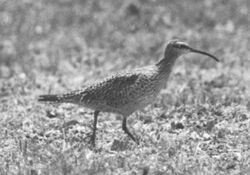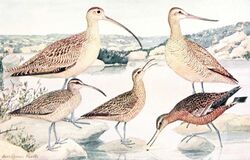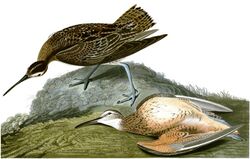Biology:Eskimo curlew
| Eskimo curlew | |
|---|---|

| |
| One of four known photographs of a living Eskimo curlew, taken by Don Bleitz on Galveston Island in 1962 | |
| Scientific classification | |
| Domain: | Eukaryota |
| Kingdom: | Animalia |
| Phylum: | Chordata |
| Class: | Aves |
| Order: | Charadriiformes |
| Family: | Scolopacidae |
| Genus: | Numenius |
| Species: | N. borealis
|
| Binomial name | |
| Numenius borealis (Forster, 1772)
| |

| |
The Eskimo curlew (Numenius borealis), also known as northern curlew, is a species of curlew in the family Scolopacidae. It was one of the most numerous shorebirds in the tundra of western Arctic Canada and Alaska. Thousands of birds were then killed per year in the late 1800s. As there has not been a reliable sighting since 1987 or a confirmed sighting since 1963, the Eskimo curlew is considered Critically Endangered or possibly extinct.[3] The bird was about 30 cm (12 in) long and fed mostly on insects and berries.
Taxonomy
The Eskimo curlew is one of eight species of curlew, and is classed with them in the genus Numenius. It used to be placed in the separate genus Mesoscolopax.[4] Numenius is classed in the family Scolopacidae. Other species in that family include woodcocks, phalaropes, snipes, and sandpipers. Scolopacidae is a Charadriiform lineage.
The species was described by Johann Reinhold Forster in 1772.[5] The generic name has three possible etymologies. One is that it comes from the Greek "noumenios". "Noumenios" means "of the new moon", the thin beak of this curlew being compared to a thin crescent moon.[6] A second possibility is that the genus name is derived from the word numen, meaning "nod", and referring to this species head being bent forward and down. The final possibility is that Numenius is a Latinized form of the Greek noumenios, which was the word Diogenes Laërtius used to refer to a species of curlew. The specific name "borealis" is Latin for "northern".[7]
This species has many common names. It has been named the prairie pigeon, fute, little curlew, doe-bird, and doughbird. These last two names come from its fatness during early migration south.[8]
Description
Eskimo curlews are small curlews, about 30 centimeters in length,[9] weighing approximately 360 g, and having a wingspan of 70 cm.[10] Adults have long dark greyish legs and a long bill curved slightly downward. The upperparts are mottled brown and the underparts are light brown. They show cinnamon wing linings in flight. They are similar in appearance to the Hudsonian curlew, the American subspecies of the whimbrel, but smaller in size.
In the field, the only certain way to distinguish the Eskimo curlew is confirmation of its unbarred undersides of the primaries.[11] The call is poorly understood, but includes clear whistling sounds.[12]
The Eskimo curlew forms a species pair with the Asian little curlew (Numenius minutus), but is slightly larger, longer-winged, shorter legged, and warmer in plumage tone than its Asian relative.
Distribution and habitat
The Eskimo curlew is a New World bird. Members of this species bred on the tundra of western Arctic Canada and Alaska.
Eskimo curlews migrated to the Pampas of Argentina in the late summer and returned in February.[9] They used to be very rare vagrants to western Europe, but there have been no recent records. In Britain, there are four records, all from the nineteenth century.[13]
A comparison of dates and migratory patterns has led some to conjecture that Eskimo curlews and American golden plover are the shorebirds that attracted the attention of Christopher Columbus to nearby land after 65 days at sea and out of sight of land on his first voyage. In the 1800s, millions of Eskimo curlews followed migration routes from the present Yukon and Northwest Territories, flying east along the northern shore of Canada, then south over the Atlantic Ocean to South America in the winter. When returning to North America, they would fly north through the Great Plains.[14]
Ecology and behavior
Diet
Eskimo curlews picked up food by sight, as well as feeding by probing. They ate mostly berries while on the fall migration in Canada. During the rest of their migration and on the breeding grounds, they ate insects. Snails and other invertebrates (including the extinct Rocky Mountain locust)[15] also were part of their diet during migration.
Reproduction
Nesting probably occurred in June. Nests were in open areas on the ground and are difficult to find. They were made of wisps of dried grass or leaves. The eggs were green with brown splotches.[8]
The specific incubation behavior of this species is unknown.[8] It is not certain which sex if not both incubated, nor what the specific timeline is. These birds evidently did not attack intruders approaching their nests, which provides reason to believe that their nests were far apart from each other.[16]
Probable extinction

At one time, the Eskimo curlew may have been one of the most numerous shorebirds in North America, with a population in the millions. As many as 2 million birds per year were killed near the end of the nineteenth century. The last confirmed sightings were in 1962 on Galveston Island, Texas (where it was photographed) and on Barbados in 1963 (where a specimen was collected). There was a reliable report of 23 birds in Texas in 1981, and a few dozen additional unconfirmed reports from scattered locales (the Northwest Territories, Texas, Ontario, Manitoba, Massachusetts, Alaska, Nova Scotia, Saskatchewan, Argentina, Guatemala, Labrador, New Jersey, and North Carolina) between 1964 and 2006.[17][18][19] No confirmed record of this species has been reported in South America since 1939. It has been suggested that the species not be treated as extinct until all possible remaining habitats have been surveyed and incidental sightings have ceased, and an assessment of critically endangered (possibly extinct) be adopted in the meantime.[1] Full details on all sightings up to 1986 are included in the online edition of Eskimo Curlew: A Vanishing Species?[20]
This species is fully protected in Argentina, Brazil, Canada, Mexico, and the United States. Hunting has been outlawed since around 1916.
In popular culture
The plight of this bird inspired the novel (and subsequent Emmy Award-winning 1972 ABC Afterschool Special) Last of the Curlews.
The Esquimaux Curlew appears as plate CCCLVII of Audubon's Birds of America.
References
- ↑ 1.0 1.1 BirdLife International (2021). "Numenius borealis". IUCN Red List of Threatened Species 2021: e.T22693170A178901365. doi:10.2305/IUCN.UK.2021-3.RLTS.T22693170A178901365.en. https://www.iucnredlist.org/species/22693170/178901365. Retrieved 12 November 2021.
- ↑ "Appendices | CITES". https://cites.org/eng/app/appendices.php.
- ↑ "Numenius borealis. NatureServe Explorer 2.0.". https://explorer.natureserve.org/Taxon/ELEMENT_GLOBAL.2.100370/Numenius_borealis.
- ↑ American Ornithologists' Union. "A classification of the bird species of South America Part 02". http://www.museum.lsu.edu/~remsen/SACCBaseline02.html.
- ↑ "Coraciiformes". zoonomen.net. http://www.zoonomen.net/avtax/frame.html.
- ↑ Terres, John K. (1980). The Audubon Society Encyclopedia of North American Birds. Knopf. p. 769. ISBN 0-394-46651-9. https://archive.org/details/audubonsocietyen00terr/page/769.
- ↑ "A Curlew By Many Other Names". Eskimo Curlew A Vanishing Species?. Nature Saskatchewan. 1986. http://www.npwrc.usgs.gov/resource/birds/curlew/names.htm.
- ↑ 8.0 8.1 8.2 Terres, John K. (1980). The Audubon Society Encyclopedia of North American Birds. Knopf. p. 776. ISBN 0-394-46651-9. https://archive.org/details/audubonsocietyen00terr/page/776.
- ↑ 9.0 9.1 Ellis, Richard (2004). No Turning Back: The Life and Death of Animal Species. New York: Harper Perennial. p. 178. ISBN 0-06-055804-0. https://archive.org/details/noturningbacklif00elli.
- ↑ "BTO BirdFacts | Eskimo Curlew" (in en). 16 July 2010. https://app.bto.org/birdfacts/results/bob5370.htm.
- ↑ Townsend, Charles W. (1933). "Sight Records of the Eskimo Curlew". Auk 50 (2): 214. doi:10.2307/4076883. http://sora.unm.edu/sites/default/files/journals/auk/v050n02/p0214-p0214.pdf.
- ↑ Gollop, J.B., ed (1986). Eskimo Curlew: A Vanishing Species?. Nature Saskatchewan Saskatchewan Natural History Society.
- ↑ Melling, Tim (2010). "The Eskimo Curlew in Britain". British Birds 103 (2): 80–92.
- ↑ Kaufman, Kenn (1996). Lives of North American Birds. Houghton Mifflin Company. ISBN 0-395-77017-3. https://archive.org/details/livesofnorthamer00kauf.
- ↑ Gill, R. E.; Canevari, P.; Iversen, E. H. 1998. Eskimo Curlew (Numenius borealis). In: Poole, A.; Gill, F. (ed.), The birds of North America, No. 347, pp. 1-28. The Academy of Natural Sciences and The American Ornithologists' Union, Philadelphia and Washington DC.
- ↑ "Life History – Briefly Stated". Eskimo Curlew A Vanishing Species?. Nature Saskatchewan. 1986. http://www.npwrc.usgs.gov/resource/birds/curlew/history.htm.
- ↑ "Eskimo Curlew Species Profile". Alaska Department of Fish and Game. https://www.adfg.alaska.gov/index.cfm?adfg=eskimocurlew.main.
- ↑ "COSEWIC Assessment and Status Report on the Eskimo Curlew Numenius borealis in Canada". Committee on the Status of Endangered Wildlife in Canada. https://www.sararegistry.gc.ca/virtual_sara/files/cosewic/sr_Eskimo%20Curlew_0810_e.pdf.
- ↑ Hoffman, Randy (2 October 2018). "A birdwatcher at Peggy's Cove, Nova Scotia, reports seeing a species presumed extinct: an Eskimo Curlew". BirdWatching. https://www.birdwatchingdaily.com/news/conservation/a-birdwatcher-at-peggys-cove-nova-scotia-reports-seeing-a-species-presumed-extinct-an-eskimo-curlew/.
- ↑ "Eskimo Curlew: A Vanishing Species?". Nature Saskatchewan. http://www.npwrc.usgs.gov/resource/birds/curlew/.
Further reading
- del Hoyo, J.; Elliott, A. & Sargatal, J. (editors) (1996): Handbook of Birds of the World, Volume 3: Hoatzin to Auks. Lynx Edicions, Barcelona. ISBN:84-87334-22-9.
- National Geographic Society (2002): Field Guide to the Birds of North America. National Geographic, Washington, D.C. ISBN:0-7922-6877-6.
External links
- BirdLife Species Factsheet.
- USGS Eskimo curlew site
- "Where Have All the Curlews Gone?" by Paul Johnsgard
- Photographs of the 1962 Texas sighting
Wikidata ☰ Q61857 entry
 |







